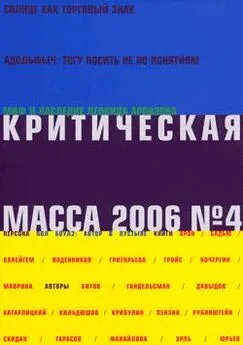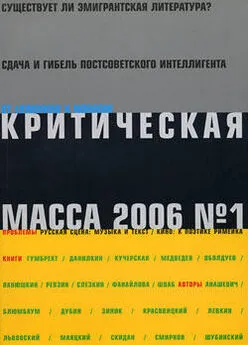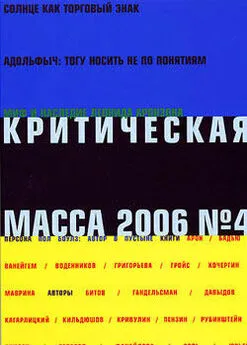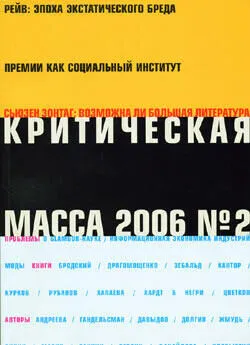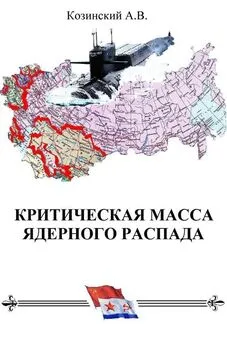Филипп Болл - Критическая масса, как одни явления порождают другие
- Название:Критическая масса, как одни явления порождают другие
- Автор:
- Жанр:
- Издательство:Гелеос
- Год:2008
- ISBN:978-5-8189-1442-8
- Рейтинг:
- Избранное:Добавить в избранное
-
Отзывы:
-
Ваша оценка:
Филипп Болл - Критическая масса, как одни явления порождают другие краткое содержание
Эти вопросы волновали человечество на протяжении веков. Томас Гоббс, Адам Смит, Иммануил Кант, Огюст Конт, Джон Стюарт Милль, Карл Маркс и другие философы рассматривали их с различных политических позиций. Однако им недоставало инструментов, которыми располагает современная физика.
Филип Болл, известный британский ученый, редактор-консультант журнала Nature, показывает, как, применяя эти инструменты, можно понять многие аспекты поведения человеческих масс. Как только человек осознает, что большинство его решений принимается под влиянием других людей, перед ним открывается неожиданная и даже, возможно, тревожная предсказуемость законов развития общества.
Настоящее издание может рассматриваться и как справочник, и как книга для чтения, рассчитанная на самый широкий круг читателей.
Критическая масса, как одни явления порождают другие - читать онлайн бесплатно полную версию (весь текст целиком)
Интервал:
Закладка:
28 N.W. Senior (1860). «Opening address of Nassau W.Senior, Esq.,...» Journal of the Statistical Society of London 23, 359.
29 F.K. Hunt (1850). «А Few Facts About Matrimony.» In Household Words 1, 374.
30 R. W. Emerson (1860). «Fate.» In The Conduct of Life & Other Essays (1908), p. 159. J.M. Dent & Sons, London.
31 M.Twain (1924). Autobiography, vol. 1, ch. 20. Harper & Brothers, New York.
32 F.Nietzsche (1874). Untimely Meditation. Second Part: Of the Use and Disadvantage of History for Life. E.W. Fritzsch, Leipzig.
33 Quoted in L. Campbell & W.Garnett (1882). The Life of James Clerk Maxwell, pp. 294-95. Macmillan, London.
34 J. C Maxwell (1873). «Molecules,» a lecture. In The Scientific Papers of James Clerk Maxwell , ed. W.D. Niven, vol. 2, p. 374. Cambridge University Press, 1890.
35 Quoted in Campbell & Garnett, pp. 438-39.
36 L.Boltzmann (1872). «Weitere Studien fiber das Warmegleichgewicht unter Gas-molekiilen.» In Wissenschaftliche Abhandlungen, ed. F.Hasenbhrl, vol. 1, p. 317. J.A. Barth, Leipzig, 1909.
37 P.G. Tait (1886). «On the foundations of the kinetic theory of gases.» In Scientific Papers, vol. 2, p. 126. Cambridge University Press, 1898-1900.
38 C S.Peirce (1877). «The fixation of belief.» Popular Science Monthly 12, 1-15. Reprinted in 1974 in Collected Papers, vol. V, p. 226. Harvard University Press, Cambridge, Mass. I am grateful to Vincent Bauchau for bringing this citation to my attention.
39 F.Galton (1875). English Men of Science: Their Nature and Nurture. D. Appleton, New York.
40 A.-A. Cournot (1843). Exposition de la theorie des chances et des probabilites, p. 181. Ha-chette, Paris.
41 J.J. Fox (1860). «On the Province of the Statistician.» Journal of the Statistical Society of London 23, 331.
42 A.Taillandier (1828). Review of «Compte general de Tadministration de la justice crim-inelle en France.» Revue encychpedique 40, 612.
43 Editorial «Introduction.» Journal of the Statistical Society of London 1, 3 (1838).
44 Quoted in M.Diamond & M.Stone (1981). «Nightingale on Quetelet.» Journal of the Royal Statistical Society A 144, 70.
45 A. de Candolle (1830). «Considerations sur la statistique des delits.» Bibliotheque uni-verselle des sciences, belles-lettres et arts, 104, 160.
46 I.Kant (1784). On History, ed. L.Beck (1963), p. 11. Indianapolis.
47 A.Quetelet (1847). «De Tinfmence de libre arbitre de Fhomme sur les faits sociaux.» Bulletin d€ la commission centrale de statistique 3 ,142.
48 A. Quetelet, SurVhomme, p. 9.
49 W.Cyples (1864). «Morality of the doctrine of averages.» Comhill Magazine 10, 224.
50 «The Address of the Prince consort on opening as President the Fourth Session of the International Statistical Congress.» Journal of the Statistical Society of London 23, 280 (I860).
51F. Dostoevsky, Letters from the Underworld, trans. C J.Hogarth, p. 32. J.M. Dent & Sons, London, 1913.
52 Ibid., pp. 29-30.
53 Ibid., p. 31.
54 L.N. Tolstoy (1869). War and Peace, trans. R.Edmunds (1969), vol. 2, p. 1,404. Penguin, Harmondsworth.
55 Ibid., p. 1,426.
56 Ibid., p. 1,440.
57 Quoted in N. Ferguson (1997). Virtual History, p. 446. Picador, London.
58 A.Tennyson (1868). «Lucretius,» p. 10. Printed for private circulation, Cambridge, Mass.
59 J. C Maxwell (1873). «Molecules.» In W.D. Niven, p. 373.
60 J. C Maxwell (1867). Letter to P.G. Tait, in C.G. Knott (1911). Life and Scientific Work of Peter Guthrie Tait, pp. 213-14. Cambridge University Press.
61 M.Smoluchowski (1918). «Uber den Begriff des Zufalls und den Ursprung der Wahrscheinlichkeitgesetz in der Physik.» In Oeuvres, vol. 3, p. 87. Krakow, 1924-28.
ГЛАВА 4. ВЕЛИКИЙ А-БУММ!
ЭПИГРАФЫ
Ralph Waldo Emerson (1860). The Conduct of Life, p. 210. J.M. Dent, London, 1908. James Clerk Maxwell (1878). In The Scientific Papers of James Clerk Maxwell ed.
W.D. Niven, vol. 2, pp. 715-17. Cambridge University Press, 1890.
Isaac Newton (1704). «Queries.» In Opticks. Reprinted by Dover, New York, 1952
1 K.Vonnegut (1965). Cat's Cradle, p. 163. Penguin, Harmondsworth.
2 M.Gladwell (2000). The Tipping Point. Little, Brown, London.
3 C.Jencks (1995). The Architecture of the Jumping Universe. Academy Editions, London
4 T.S. Kuhn (1962). The Structure of Scientific Revolutions. University of Chicago Pres
5 J. F. W. Herschel (1830). Preliminary Discourse on the Study of Natural Philosophy, p. 188. Longmans Brown, Green & Longmans, London, 1851.
6 T. Andrews (1869). «On the continuity of the gaseous and liquid states of matter.» Philo sophical Transactions of the Royal Society 159 , 575.
7 J.C. Maxwell (1874). «Van der Waals on the continuity of the gaseous and liquid states» Nature 10, 477-80, here p. 478.
ГЛАВА 5. О РОСТЕ И ФОРМЕ
ПИГРАФЫ
tephen Hales (1727). Vegetable Staticks. W. & J.Innys & T.Woodward, London, lerbert Spencer (1876). The Principles of Sociology. Quoted in R.Bierstedt, ed. (1959).
The Making of Society, p. 262. Random House, New York.
Jeorg Christoph Lichtenberg, quoted in F.Cramer (1993). Chaos and Order, p. 2. VCH, Weinheim.
1 H.D. Thoreau (1856). The Journal of Нету David Thorcau, ed. B.Torrey & F. Allen, vol. 8, pp. 87-88. Houghton Mifflin, Boston, 1906.
2 J.W. Gibbs (1906). «On the equilibrium of heterogeneous substances.» In The Scientific Papers ofJ .Willard Gibbs, vol. I, ed. H.A. Bumstead & R.G. Van Name. Longmans, Green, New York.
3 D. W. Thompson (1917). On Growth and Form, p. 503. Revised edition published by Cambridge University Press, 1942, and reprinted in 1992 by Dover, New York.
4 Ibid., p.505.
5 I.Prigogine (1980). From Being To Becoming, p. 106. W.H. Freeman, New York.
6 J.L. Borges (1956). «The Garden of Forking Paths.» In Labyrinths, pp. 44-54. Penguin, Harmondsworth, 1970.
7 Prigogine, p. 106.
ГЛАВА 6. МАРШ РАЗУМА
ПИГРАФЫ
Jeorg Christoph Lichtenberg, quoted in F.Cramer (1993). Chaos and Order, p. 114. VCH, Weinheim.
Edward A.Ross (1901). Social Control. In R.Bierstedt (1959), The Making of Society, p. 336. Random House, New York.
[einrich von Kleist (1810). On the Marionette Theatre. In Berliner Abendblatter, 12-15 December. Trans. I. Parry in the Times Literary Supplement, 20 October 1978.
1 A. van Leeuwenhoek (1674). In Antony van Leeuwenhoek and His Little Animals / Trans. & ed C. Dobell (1958). Russell & Russell, New York.
2 Hobbes, Leviathan, p. 228.
3 J.K. Parrish & L.Edelstein-Keshet (1999). «Complexity, pattern, and evolutionary trade-offs in animal aggregation.» Science 284, 99-101, here p. 100.
4 Quoted in S.Levy (1992). Artificial Life, p. 74. Jonathan Cape, London.
5 Quoted in R.Lewin (1992). Complexity, p. 178. Macmillan, New York.
6 Hobbes, Leviathan, p. 225.
7 Ibid, pp. 225-26.
eL F Henderson (1971). «The statistics of crowd fluids.» Nature 229, 381.
* BHilher & J.Hanson (1984). The Social Logic of Space, p. 266. Cambridge University Press.
10 Ibid.
11 MBatty, J.Desyllas and E.Duxbury (2003). «Safety in numbers? Modelling crowds and designing control for the Notting Hill Carnival.» Urban Studies 40, 1573-90, herep. 1588.
12 Ramsh & Edelstein-Keshet, р. 101.
13 R Ackroyd (2000). London: The Biography, p. 2. Chatto & Windus, London.
14 Ibid, p. 103.
15 H Ketl (1787). Quoted in Ackroyd, p. 517.
16 DDT Chen (2000). The science of smart growth.» Scientific American, December, pp. 84-92.
17 Ibid.
18 L Mumford (1938). The Culture of Cities, p. 233. Seeker & Warburg, London.
19 Ibid, p. 7.
20 H. Spencer (1876). Principles of Sociology. Quoted in R.Bierstedt, ed. (1959). The Making of Society, p. 262. Random House, New York.
21 Quoted in I.Petersen (1996). «The shapes of cities.» Science News 149, 6 January, p. 9.
22 H.Simon (1996). The Science$ of the Artificial, 3rd ed., pp. 33-34. MIT Press, Cambridge, Mass.
23 Ackroyd, p. 588.
ГЛАВА 7. ПУТИ-ДОРОГИ
ЭПИГРАФЫ
Thomas C.Schelling (1978). Micromotives and Macrobehavior, p. 121. W.W. Norton, New York.
Josiah Willard Gibbs, quoted in A.T. Winfree (1980). The Geometry of Biological Tim Springer-Verlag, New York.
Rudyard Kipling (1888). L’Envoi to The Story of the Gadsbys. A.H. Wheeler & Co., Allahabad.
1R.Moe (1999). Speech on urban sprawl, Red Hills Spring Event Dinner, Tall Timbers Research Station, Tallahassee, Florida, 24 March.
ГЛАВА 8. РИТМЫ ТОРГОВОЙ ПЛОЩАДИ
ЭПИГРАФЫ
Samuel Johnson, quoted in R.Heilbroner (2000). Иге Worldly Philosophers, 7th ed., p. 41. Penguin, London.
George Bernard Shaw (attributed).
Johann Wolfgang von Goethe, quoted in R.W. Emerson (1860). The Conduct of Life, p. 197. J.M. Dent, London, 1908.
1 Heilbroner, p. 57.
2 D.Defoe (1706). Review, vol. ii, p. 26. Quoted in D.Donoghue (1988). England, Their England: Commentaries on English Language and Literature, p. 65. Alfred A. Knopf, New York.
3 Quoted in J.G. A. Pocock (1985), «Josiah Tucker on Burke, Locke, and Price.» In Virtue, Commerce and History: Essays on Political Thought and History, Chiefly in the Eighteenth Century, pp. 157-91. Cambridge University Press.
4 Emerson, The Conduct of Life, p. 202.
5 Ibid.
6 J.Kay (1995). «Cracks in the crystal ball.» Financial Times, 29 September.
7 I. Fisher (1929). Quoted in R.Heilbroner, p. 251.
8 P.Krugman (1994). Peddling Prosperity p. xi. W.W. Norton, New York.
9 Ibid.
10 K.Marx & F.Engels (1848). The Communist Manifesto, trans. S.Moore, p. 25. Junius Publications, London, 1996.
11 Ibid., p. 48.
12 P. H. Cootner, ed. (1964). The Random Character of Stock Market Prices. MIT Press, Cambridge, Mass.
13 Quoted in G.Stix (1998). «А calculus of risk.» Scientific American, May, 70-75.
L7Ii\BA 9. АГЕНТЫ ФОРТУНЫ
ЭПИГРАФЫ
Robert Heilbroner (1999), The Worldly Philosophers, 7th ed., pp. 316-17. Penguin, London.
Ral Waldo Emerson (1860). The Conduct of Life, p. 199. J.M. Dent, London, 1908.
Brian Arthur, quoted in M.M. Waldrop (1994), Complexity, p. 328. Penguin, London.
1 T.Carlyle (1849). «The Nigger question.» In Miscellaneous Essays, vol. 7, pp. 79-110. Chapman & Hall, London, 1888.1 recommend P.Groenewegen’s «Thomas Carlyle, ‘the dismal scienc»,’ and the contemporary political economy of slavery,» History of Economics Review 34, 74-94 (2001) for a discussion of Carlyle’s critique of «economic science» and his views on the economic implications of the emancipation of slaves.
Читать дальшеИнтервал:
Закладка:


